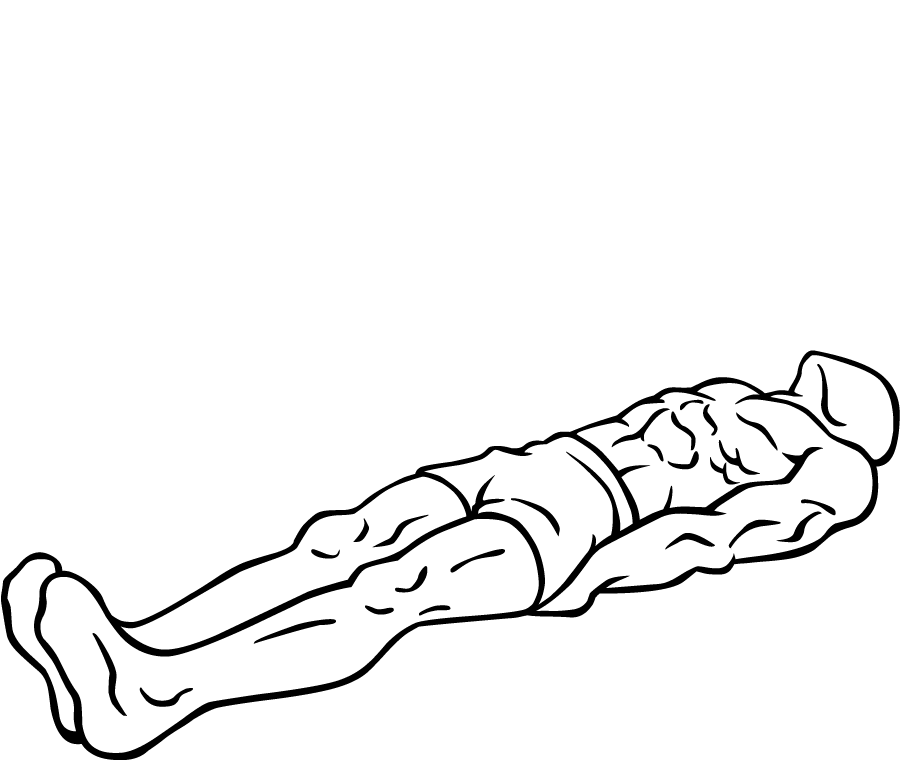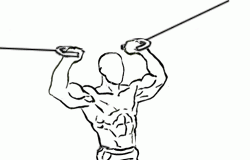Last Updated on September 30, 2014
The Flat Bench Leg Raises is an excellent exercise for targeting the lower abdominal muscles, helping you build core strength and improve stability. It’s a highly effective move for isolating the lower abs, which are often more difficult to engage than the upper abdominals. This exercise is a staple in many core workout routines, as it not only strengthens the lower abs but also helps improve overall core stability and lower back support. Additionally, Flat Bench Leg Raises can be modified to suit all fitness levels, making it an accessible movement for beginners and advanced athletes alike.
In this blog, we’ll explore the benefits of the Flat Bench Leg Raises, break down proper form and technique, highlight common mistakes to avoid, and discuss variations you can try to keep your core workouts challenging and effective. Whether your goal is to build a stronger core, tone your lower abs, or improve your overall fitness, the Flat Bench Leg Raise is a movement you’ll want to include in your routine.
Why the Flat Bench Leg Raise?
The Flat Bench Leg Raise is a particularly effective lower abdominal exercise because it focuses on engaging the muscles responsible for raising and lowering your legs. These muscles, known as the rectus abdominis and hip flexors, are crucial for core stability and strength. Here’s why this exercise should be a key component of your ab workouts:
- Targets the Lower Abdominal Muscles: Many ab exercises, such as crunches and sit-ups, primarily engage the upper part of the rectus abdominis, leaving the lower abs underworked. The Flat Bench Leg Raises is one of the few exercises that specifically isolates and targets the lower part of the abdominal muscles, helping to create a balanced and well-defined core.
- Improves Core Stability: Strengthening your lower abs is essential for maintaining a strong and stable core. A stable core is crucial for overall body movement, posture, and the ability to perform other exercises effectively, such as squats, deadlifts, and even running.
- Supports Lower Back Health: A strong lower abdominal region helps protect the lower back by reducing the strain placed on it during movement. When your core is strong, your lower back doesn’t have to compensate for weaknesses, which can help prevent injuries and alleviate lower back pain.
- Improves Hip Flexor Strength: The hip flexors play a significant role in raising the legs during the Flat Bench Leg Raise. Strengthening these muscles can improve overall mobility and athletic performance, especially in movements that require lifting or raising the legs, such as sprinting, jumping, or kicking.
- Promotes Better Posture: A strong core is essential for maintaining good posture. By regularly performing the Flat Bench Leg Raise, you’ll develop the lower abdominal muscles needed to support your spine and improve your overall posture.
- Versatile and Accessible: This exercise requires only a flat bench, making it a versatile movement that can be performed at the gym or at home. It’s also easy to modify, allowing beginners to start at their own pace and advanced athletes to add variations for increased intensity.
Muscles Worked in Flat Bench Leg Raises
The Flat Bench Leg Raises primarily targets the lower portion of the rectus abdominis, the muscle that runs vertically down the front of your abdomen. However, several other muscle groups are also engaged to support the movement:
- Rectus Abdominis (Lower Abs): The main muscle group targeted during the Flat Bench Leg Raise is the lower part of the rectus abdominis. This muscle is responsible for flexing the spine and raising the legs, making it essential for core stability and abdominal strength.
- Hip Flexors: The hip flexors, which include muscles such as the iliopsoas and the rectus femoris, are activated as you lift your legs. These muscles work alongside the lower abs to raise and lower the legs during the exercise.
- Obliques: While the focus is on the lower abs, the oblique muscles (located on the sides of your torso) are also engaged to help stabilize the core and keep your body aligned during the movement.
- Lower Back: The muscles of the lower back, particularly the erector spinae, are involved in stabilizing your spine and preventing excessive arching. A strong core ensures that your lower back remains supported during the movement, reducing the risk of injury.
- Quadriceps (Front Thighs): The quads assist in stabilizing your legs as you raise and lower them, although they aren’t the primary focus of the exercise. This added engagement helps improve leg stability and strength.
Step-by-Step Guide to Performing Flat Bench Leg Raises
Equipment Needed:
- Flat Bench: This provides support for your body and allows you to perform the exercise with proper form.
- Optional Support: If you have lower back issues or need additional support, you can use a towel or small cushion under your lower back for comfort.
Starting Position:
- Lie Flat on the Bench: Begin by lying flat on a bench with your hands positioned under your hips. Placing your hands under your hips helps support your lower back and maintain proper alignment throughout the exercise.
- Position Your Legs: Extend your legs straight out, keeping them together. Your feet should be off the bench, with only your hips and upper body in contact with the bench. Flex your toes upwards toward your shins to engage your lower legs and core.
- Engage Your Core: Before starting the movement, tighten your abdominal muscles to engage your core. This will help you maintain stability and prevent your lower back from arching during the exercise.
The Movement:
- Lift Your Legs: Begin by lifting your straight legs a few centimeters off the bench. This is your starting position. From here, slowly raise your legs upward while keeping them straight, with a slight bend in the knees. Continue lifting until your legs are just shy of a 90-degree angle with your hips.
- Pause and Squeeze: Once your legs reach the top of the movement, pause for a moment and squeeze your lower abdominal muscles. This contraction helps to maximize muscle engagement and strengthen the lower abs.
- Lower Your Legs Slowly: In a slow and controlled manner, lower your legs back down to the starting position. As you lower your legs, keep your core engaged and avoid letting your lower back lift off the bench. Your legs should hover just above the bench at the bottom of the movement, maintaining tension in your abs.
- Repeat: Perform the exercise for 10–15 repetitions, depending on your fitness level. Aim for 3–4 sets to fully engage the lower abdominal muscles and build strength.
Tips for Proper Form and Technique
- Keep Your Lower Back Pressed Against the Bench: One of the most important aspects of this exercise is keeping your lower back flat against the bench. If your back starts to arch, it can place unnecessary strain on your lower back and reduce the effectiveness of the movement. Engage your core throughout the exercise to prevent this from happening.
- Use Controlled Movements: Avoid using momentum to lift or lower your legs. Instead, focus on slow, controlled movements that allow you to engage your lower abdominal muscles fully. Lowering your legs too quickly can reduce the effectiveness of the exercise and increase the risk of injury.
- Don’t Lock Your Knees: While your legs should remain straight throughout the movement, avoid locking your knees. A slight bend in the knees will help protect your joints and ensure that your muscles are doing the work.
- Breathe Properly: Inhale as you lower your legs and exhale as you lift them. Proper breathing helps maintain stability and prevents you from holding your breath, which can cause unnecessary tension in the body.
- Keep Your Hands Under Your Hips: Placing your hands under your hips provides extra support for your lower back, especially if you have back issues. This position also helps you maintain proper form by preventing your back from arching during the movement.
Common Mistakes to Avoid
- Arching Your Back: One of the most common mistakes in this exercise is allowing the lower back to arch off the bench as you lower your legs. This can strain your back and reduce the effectiveness of the exercise. Always focus on keeping your back flat against the bench and your core engaged.
- Using Momentum: Rushing through the movement and using momentum to lift your legs can diminish the impact on your lower abs. Ensure that each rep is performed slowly and with control to fully engage the muscles and achieve the best results.
- Lifting the Head and Shoulders: Some people tend to lift their head and shoulders off the bench during the exercise, which can create tension in the neck. Keep your upper body relaxed and in contact with the bench throughout the movement.
- Not Engaging the Core: Failing to engage the core can result in improper form and a lack of muscle activation. Always focus on tightening your abs before you begin each rep to ensure proper form and maximum effectiveness.
- Bending the Knees Too Much: While a slight bend in the knees is fine, excessively bending the knees reduces the challenge for the lower abs and shifts some of the work to the hip flexors. Keep your legs as straight as possible to target the lower abs effectively.
Variations of Flat Bench Leg Raises
Once you’ve mastered the traditional Flat Bench Leg Raise, try these variations to add intensity and variety to your core workouts:
- Weighted Leg Raises: To increase the difficulty, add ankle weights or hold a light dumbbell between your feet as you perform the leg raises. This added resistance challenges your lower abs even more.
- Leg Raises with a Stability Ball: Place a stability ball between your feet and hold it throughout the movement. This variation adds an extra challenge to your core stability and requires additional focus on keeping the ball in place. As you lift and lower your legs, the instability of the ball forces your core and leg muscles to work harder.
- Hanging Leg Raises: If you’re looking for a more advanced version, try performing leg raises while hanging from a pull-up bar. This variation places more emphasis on the lower abs and increases the difficulty by removing the support of the bench. Hanging leg raises also engage your upper body and grip strength, making it a full-body challenge.
- Incline Bench Leg Raises: For a slightly easier variation, you can perform leg raises on an incline bench. This reduces the resistance on your lower abs by allowing gravity to assist with the movement, making it a great option for beginners or those recovering from an injury.
- Flutter Kicks: Perform small, alternating leg raises, where one leg stays raised while the other lowers. This constant motion provides a continuous burn to your lower abs and hip flexors, making it an excellent endurance-building exercise.
- Reverse Crunch: For a different angle on targeting the lower abs, add reverse crunches to your routine. Begin in a similar starting position, but instead of raising your legs, curl your hips off the bench and bring your knees toward your chest. This movement shifts the focus onto your lower abs and improves core stability.
How to Incorporate Flat Bench Leg Raises into Your Routine
The Flat Bench Leg Raises can be incorporated into a variety of workout routines, whether you’re focusing on core strength or overall conditioning. Here are some ways to include it effectively:
- Core-Focused Workouts: If you’re dedicating a session to core strength, Flat Bench Leg Raises can serve as one of your primary exercises. Pair it with other lower ab-focused movements like bicycle crunches, planks, and hanging knee raises for a comprehensive core workout. Aim for 3–4 sets of 10–15 repetitions to fully engage your lower abs.
- Full-Body Workouts: Incorporate Flat Bench Leg Raises into a full-body workout by including them after larger compound movements like squats, deadlifts, and overhead presses. This will ensure that your core is getting direct attention after your major lifts.
- Supersets and Circuits: To increase the intensity of your workout, combine Flat Bench Leg Raises with another core or lower body exercise in a superset or circuit. For example, perform a set of leg raises followed by bicycle crunches or Russian twists. This will keep your core under constant tension and improve endurance.
- As a Finisher: After completing your main workout, use Flat Bench Leg Raises as a finisher to fully fatigue your core. Perform a high-rep set or combine it with other ab exercises like planks and mountain climbers to end your workout on a high note.
Sample Core Workout Incorporating Flat Bench Leg Raises
Here’s an example of a core-focused workout that includes Flat Bench Leg Raises:
- Warm-Up: 5–10 minutes of light cardio (e.g., jogging or jumping jacks) followed by dynamic stretching.
- Plank: 3 sets of 30–45 seconds.
- Flat Bench Leg Raises: 3 sets of 12–15 repetitions, focusing on slow and controlled movements.
- Bicycle Crunches: 3 sets of 20 repetitions (10 per side).
- Russian Twists: 3 sets of 20 repetitions (10 per side).
- Flutter Kicks: 3 sets of 30–45 seconds.
- Cool Down: Static stretching focusing on the core and hip flexors.
This workout will help build core strength, improve stability, and target your lower abs effectively.
Benefits of Consistent Flat Bench Leg Raise Training
Incorporating the Flat Bench Leg Raise into your regular workouts can yield a range of benefits, especially for your core strength and overall stability. Here are some of the key advantages:
- Stronger Lower Abs: Flat Bench Leg Raises are one of the best exercises for isolating the lower abdominal muscles, helping you build a more defined and powerful core.
- Improved Core Stability: A strong core is essential for maintaining stability during other exercises and in everyday movements. Consistently performing leg raises will enhance your ability to maintain balance and stability in various activities.
- Better Posture and Lower Back Health: Strengthening your lower abs helps improve posture and reduces the risk of lower back strain. A stable core supports the spine, alleviating pressure on the lower back during activities that involve bending, lifting, or standing for extended periods.
- Enhanced Athletic Performance: Strong lower abs and hip flexors are crucial for explosive movements like sprinting, jumping, and kicking. Flat Bench Leg Raises can help improve your performance in these activities by strengthening the muscles responsible for leg and hip motion.
- Toned Midsection: If your goal is to develop a well-defined midsection, incorporating Flat Bench Leg Raises will help tone and sculpt your lower abdominal muscles, contributing to a balanced, lean physique.
The Flat Bench Leg Raises is a highly effective exercise for strengthening the lower abdominal muscles, improving core stability, and supporting lower back health. By focusing on proper form and controlled movements, you can maximize the benefits of this exercise and develop a stronger, more defined core.
Whether you’re new to fitness or an experienced athlete, the Flat Bench Leg Raise is a versatile movement that can be modified to suit your fitness level. From standard leg raises to weighted variations and hanging leg raises, there are plenty of ways to keep this exercise challenging and engaging.
Incorporate Flat Bench Leg Raises into your core workouts, full-body routines, or even as part of a finisher to fully engage your abs and improve your overall fitness. With consistent effort, you’ll soon notice stronger, more defined lower abs and a more stable, powerful core.
So, the next time you’re at the gym or working out at home, lie down on that bench, engage your core, and start raising your way to a stronger, more toned midsection!








